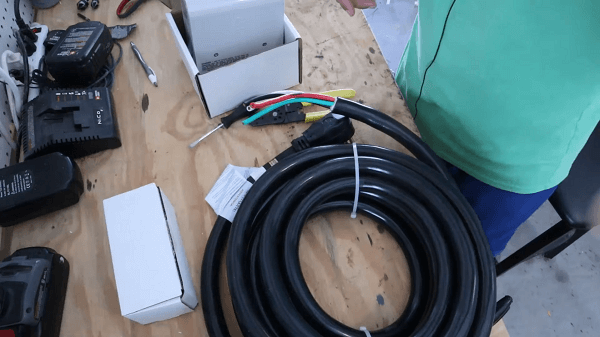Table of Contents
If you want to know how to make a 220 V extension cord, consider this your complete guide! A 220V extension cord is super useful when you need to run a heavy-duty, high-powered tool or appliance.
With the right tools and determination, you can learn how to make a 220 extension cord rather than running to the store. But extension cords can be dangerous, so adhere to all safety tips in this article while making your extension cord.
What Is a 220 V Extension Cord?
A 220v extension cord is used for high-amperage tools and appliances. Depending on the design, these cords are 220 volts and sometimes up to 240.
This voltage amount is the standard power system used in Europe, so these cords are handy. In the U.S., 220-volt outlets are for high-powered tools and electric car charging.
Sometimes this cable is incorrectly called a 220-amp cord, but the number refers to the voltage, not the amperage.
Using a 220-volt power extension cord for high-powered appliances is necessary to avoid safety issues. Using a flimsy cord not equipped for high voltage and amperage is dangerous.
Amperage and Voltage
To understand why you might need to know how to make a 220v extension cord, you should first know how amperage and voltage work in these cords.
Amperage measures the rate electrons flow at, while voltage measures the pressure placed on the free electrons, which makes them flow, causing amps. Voltage indicates how much force is necessary to move a single amp down a conductor.
Using a 220V extension cord with power tools ensures the wires can handle the force it takes to create the amps. Using an extension cord with lower voltage levels can cause issues and pose safety hazards.
How To Make A 220 V Extension Cord
Once you have all the materials you need, you can learn how to make a 220 extension cord using the instructions below. Take your time and read each step carefully, as you should always practice caution when handling exposed wiring and electric tools.
Each step is both for the male and female end. Even though they look different they operate the same.
Tools and Materials:
To make a 220-power extension cord, you’ll need a few tools and materials. Before you can begin, gather the materials and tools listed below:
- Wire cutters and strippers
- Multimeter
- Measuring tape
- Safety gloves
- Screwdriver
- New male and female plugs
1. Plan ahead
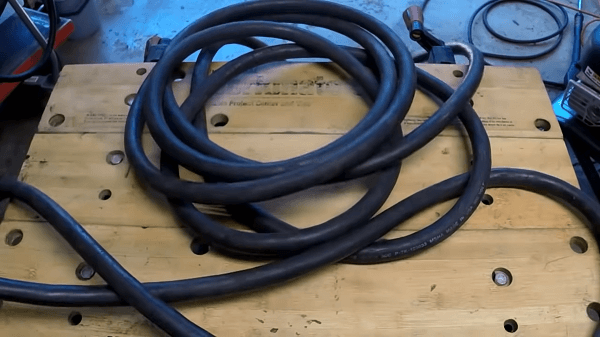
The first step is to measure how long the power extension cord needs to be. For this step, take your time and check your measurements to avoid delays and wasting materials.
Determine how much voltage and amperage the current cord must carry and what type of connectors you need at each end.
2. Set the plugs

Take a piece of cable long enough to meet your needs. Ensure this cable follows regulations and safety guidelines of governing bodies such as the Consumer Product Safety Commission.
After you take the plug apart, slide the male and female plugs onto the new cable. Move the cable so about five or six inches of the cord goes through the new male and female plug housing. Allow enough cord length to hold it safely mark the length.
3. Strip the cable
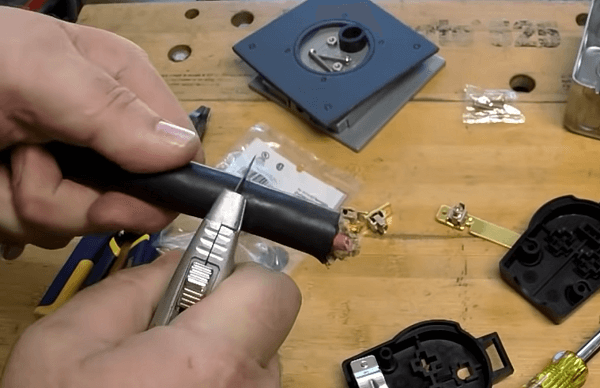
Strip off about two or three inches of the insulation sleeve to expose the three inner wires. Be careful not to damage the inner wires or outer sleeves of the wires. Clear any excess isolation in the cable.
Cut the internal wires, one at a time, so they are straight and can reach the plug terminals you need to use.
4. Strip the wires
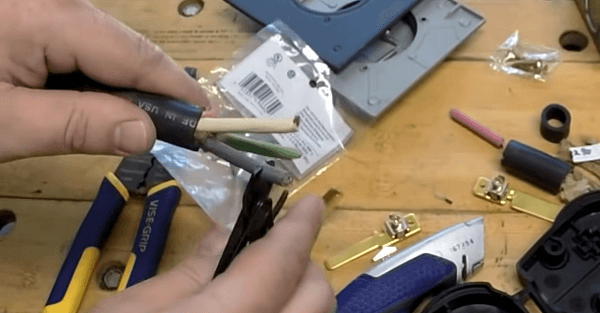
Using the wire strippers, bare the wire ends and leave a quarter of an inch of exposed metal. Do this for all three wires on both sides.
5. Connect to the terminal
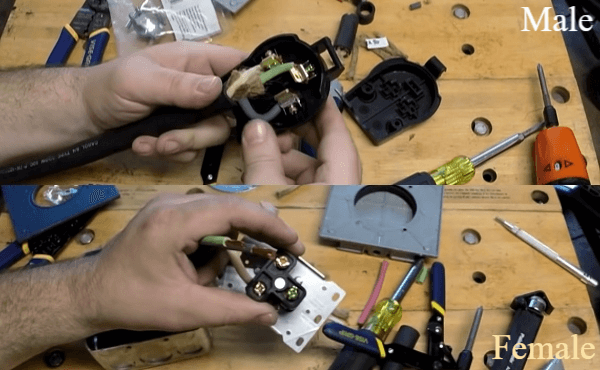
Insert the exposed wires into the terminals. The grounding wire goes into the green terminal. The hot wire, which is black, goes into the brass terminal. And lastly, the neutral wire, which is white, goes into the silver terminal.
Tighten the terminal screws and trim any excess wire on the other side. Make sure the wires connect to the terminals, so take your time with steps eight and nine. Attach the cord clamp where there is still an insulation cover over the wires. Make sure the cables are not kinked or trapped incorrectly.
6. Assemble the plug
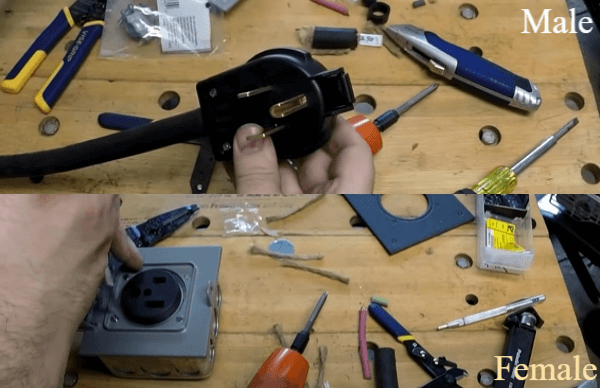
Assemble the plug housing. Check the continuity of the current using a multimeter. To do this, attach the multimeter probes to the hot prongs. Repeat this process on the two neutral prongs, then do it for the two grounding prongs. Once all three multimeter tests show a connection between the wires, your 220 volt extension cord is ready to use!
Look at a 220V extension cord wiring diagram to give you a visual of you want to set up the wiring. Make sure to take your time and follow the instructions carefully, or watch a YouTube video to help guide you.
Uses of A 220v Extension Cord
If you’re wondering what 220V extension cords are for, there’s a quick list below. When using any of these items, place it safely and use a heavy-duty extension cord like the 220-volt cords.
An extension cord with less voltage or amperage capabilities can cause hazards or damage to your tools and appliances.
- Welding: A 220 extension cord for welding is the best option to ensure the tools operate safely.
- Buzzsaw: Buzz saws is a powerful tool that needs a 220V extension cord to run.
- Power Drill: Power drills are one of the most common tools that need a 220V extension cord.
- Bandsaw: Even though bandsaws are more lightweight than buzz saws, they’re still heavy-duty and need a 220V cord.
- Dryer: You almost always need a 220 extension cord for a dryer because they use so much electricity at once.
- Stove: You will need a 220 extension cord for stoves and ovens.
- Air Conditioner: Super high-capacity air conditioners often need a 220V cord.
- RV Power: Extension cords used for RV power are typically 220V, so they can handle a lot of power.
- Car Charging: In the US, 220V cords charge electric cars like Teslas.
- Europe: As mentioned, 220V extension cords are super common in Europe and used for many tools and appliances, not just heavy-duty ones.
Hazards of Using the Wrong Extension Cord
In general, extension cords can pose a hazard. Even when used properly, they’re still a risky tool because it adds more wattage. Always use extension cords with caution and play it on the safe side. The section below details the hazards to be aware of when using any extension cord.
Overheating
If the extension cord you choose does not have enough voltage capacity for the tool it’s plugged into, it can cause overheating. When an extension cord overheats, it can spark and cause a fire, especially if it’s near flammable objects like curtains or blankets.
Appliance Damage
Another tragic thing that can happen when you use an inadequate extension cord is the power can shoot back and damage your appliance.
Using the wrong cord may result in a ruined power drill or dryer, which is an expensive fix. Using the correct power cord first is better to avoid damage to your property.
Risk of Injury
Using the wrong extension cord can result in personal injury. For example, you may electrocute or burn yourself when using a wire unsuitable for the tool’s power.
Safety Tips For Using Extension Cords
Safety should always come first, especially with electrical appliances and cables. Follow the safety tips below whenever you handle extension cords.
- Do not remove an extension cord’s grounding pin in any circumstance.
- Do not power multiple appliances with one cord.
- Do not use indoor cords outside.
- Do not plug extension cords into extension cords.
- Do not tape extension cords to floors or walls.
- Do not nail or staple extension cords.
- Do not bend extension cords when plugged in.
- Use child-proof covers.
- Unplug an extension cord if it feels hot.
Caring For Extension Cords
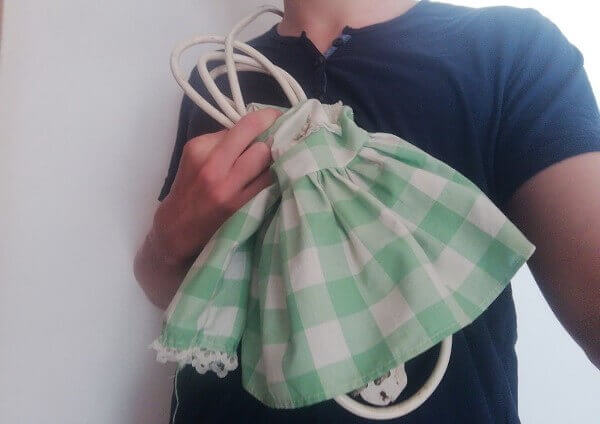
You want your extension cords to last, whether a custom-made 220V or just a store-bought cable. Follow the tips below to help your extension cords last longer and work better.
- Always store cords indoors, rather than in your garage or an outdoor shed.
- Unplug extension cords whenever they are not in use. Leaving them plugged in is hazardous and bad for the product.
- Do not try to repair fraying or damaged cords. If you notice any damage to an extension cord, especially near the plug, dispose of it.
- When unplugging an extension cord, pull the plug directly out of the outlet or appliance, do not pull on the cord to unplug it.
Frequently Asked Questions
Here are some commonly asked questions about 220V extension cords or making custom cords. Most of these questions come up among Americans, as 220V cords are commonplace in Europe and other countries.
How long can a 220-volt extension cord be?
A 220-volt extension cord should not be longer than 100 feet, which is good for 15 amps to run any power tool safely. Use a 12-gauge cord.
Can I use a 110V extension cord with 220V?
If the tool or appliance is 110V, you can do this. But if the appliance is 220V, you should not use the 110V in tandem with the 220V cord, as this is dangerous.
What type of wire do you use for 220 volts?
Most 220V extension cords use a 10-2 copper wire suited for a 30 amp circuit. But it can also handle up to 40 amps of constant load.
Is 240V the same as 220V?
In general, 240V, 230V, and 220V extension cords are the same. This fact may differ in Europe and other countries, but these voltage levels fall into the same category in America.
Are custom-made cords safe to use?
Using a custom cord is safe if you follow proper instructions and safety guidelines. Custom-made extension cords are suitable for heavy-duty power tools but can be dangerous in other situations. Use the multimeter to test any custom-made cord before use to ensure it was made correctly.
Can I buy a 220V extension cord?
Absolutely! If you’re not comfortable making your own 220V cord, you can just buy one. And there are excellent 220V to 240V extension cords on the market!
How does a power-down transformer wire into 220 wirings?
To use a power-down transformer with a 220V extension cord, you need to terminate the input power wires and cut them to fit the lug. It involves removing the outer insulating cover so the current can flow through the wire safely. Then, the proper voltage will flow through the transformer and cord.
Making a 220 Extension Cord
Once again, prioritize safety over everything. Do not use a custom-made extension cord unless it passes the multimeter tests. And when in doubt, stop using it.
A lot can go wrong with these cords, and electricity causes more than 300 deaths and 4,000 injuries in the U.S. annually. So take your time and be careful!

